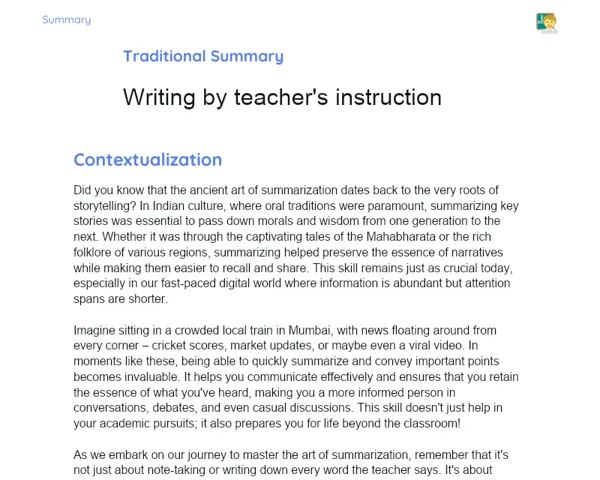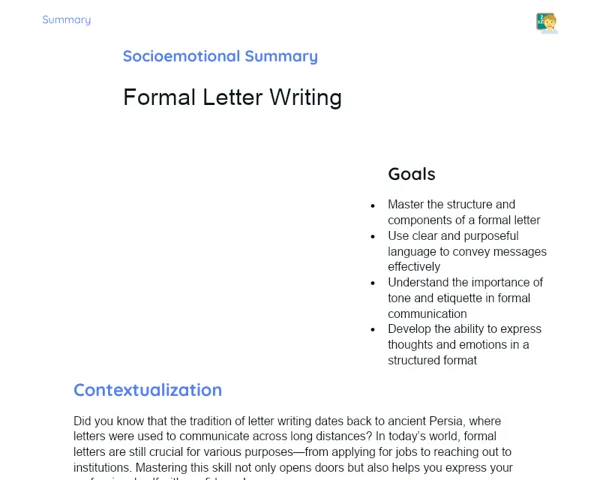Socioemotional Summary Conclusion
Goals
1. Identify and recognise the key phrasal verbs in different contexts.
2. Comprehend the meanings and uses of phrasal verbs, and use them accurately in sentences.
Contextualization
Have you ever thought about how challenging it would be to communicate in English without phrasal verbs? They pop up in nearly every conversation! It's akin to picking up slang or popular phrases in Hindi, like 'kya scene hai?' which can mean different things based on when and how it’s used. Mastering phrasal verbs will not only aid in making your English sound more natural but will also boost your confidence in both social and academic settings! 🚀
Exercising Your Knowledge
Definition of Phrasal Verbs
Phrasal verbs are phrases that combine a main verb with a preposition or adverb (or both) creating new meanings. They are essential tools for effective communication in English, allowing for expressing thoughts in a more natural, conversational manner.
-
Unique Combination: Phrasal verbs are formed by linking a verb with a preposition or adverb to convey a new meaning. Example: 'give up'.
-
Contextual Meaning: The meaning of a phrasal verb can shift based on the context in which it is used, making it crucial to grasp them for clear communication.
-
Everyday Use: Commonly featured in daily conversations, phrasal verbs are vital for anyone wanting to speak and write English fluently.
Types of Phrasal Verbs
There are three key types of phrasal verbs: transitive, intransitive, and separable/inseparable. Recognising these types aids in effectively using them in various contexts.
-
Transitive: These require a direct object to convey meaning. Example: 'She looked after the children.'
-
Intransitive: These don't need a direct object. Example: 'He wakes up early.'
-
Separable and Inseparable: Some phrasal verbs can be separated by an object, while others cannot. Example: 'She put the book down' (separable) and 'She looks after the children' (inseparable).
Importance of Phrasal Verbs
Phrasal verbs are commonly used in daily English communication. Mastering them helps you sound more authentic and fluent, while also boosting your confidence in social and academic exchanges.
-
Natural Communication: Using phrasal verbs brings your English closer to how native speakers communicate.
-
Confidence: Mastering phrasal verbs will make you feel more self-assured in daily conversations.
-
Social Tool: Phrasal verbs help navigate informal and cultural conversations, enhancing social integration.
Key Terms
-
Phrasal Verbs: Combinations of verbs with prepositions or adverbs that come with new meanings.
-
Transitive: Phrasal verbs that necessitate a direct object.
-
Intransitive: Phrasal verbs that do not demand a direct object.
-
Separable/Inseparable: Types of phrasal verbs that can or cannot be disconnected by the object in a sentence.
For Reflection
-
How did you feel while learning about phrasal verbs? What emotions did it stir up?
-
In what ways do you think mastering phrasal verbs can influence your confidence during social interactions?
-
What strategies can help alleviate anxiety when speaking in public or using new phrasal verbs?
Important Conclusions
-
Phrasal verbs are combinations of a verb with prepositions or adverbs that yield new meanings, making them essential for everyday communication in English.
-
There are three primary types of phrasal verbs: transitive, intransitive, and separable/inseparable, each with distinct characteristics affecting their use.
-
Mastering phrasal verbs enhances your naturalness and fluency in English, boosting your confidence in both social situations and academic contexts.
Impacts on Society
Phrasal verbs hold a significant place in our modern society, particularly in global settings where English serves as a lingua franca. In a closely-knit world, effective and natural communication in English opens doors across education, business, and social networks. Knowing and using phrasal verbs correctly enhances fluency and aids integration into various cultures, fostering inclusive and empathetic communication.
Emotionally speaking, becoming proficient in phrasal verbs can transform your experience of learning and speaking English. Many students feel anxious or unsure when using the language, particularly in public speaking or when interacting with natives. By practising and frequently using phrasal verbs, these feelings can diminish, leading to greater self-assurance and comfort. The sense of achievement from learning and applying a new phrasal verb can also ignite motivation to continue studying.
Dealing with Emotions
Let's engage in a practical exercise to manage emotions while learning phrasal verbs. First, carve out some quiet time at home and reflect on how you felt while learning about phrasal verbs. Jot down any emotions that sprang up (e.g., nervousness, excitement, frustration) in a notebook. Then, try to identify what triggered these emotions and how they impacted your performance. Label these emotions accurately and articulate them, whether to yourself, in a journal, or by discussing with someone you trust. Finally, brainstorm strategies to regulate these emotions the next time a similar situation arises, like breathing exercises, extra practice, or seeking help from a friend. By doing this, you will be employing the RULER method to enhance both your English learning and emotional well-being.
Study Tips
-
Practice regularly: Set aside time each day to review and practice new phrasal verbs, reinforcing your understanding and helping them feel more instinctive.
-
Use in context: Make an effort to weave phrasal verbs into your daily chats, whether chatting with friends, sending messages, or even thinking in English.
-
Create flashcards: Prepare flashcards featuring the phrasal verb on one side and its meaning on the other. Use them for self-testing or engaging activities with peers to make studying interactive and enjoyable.



